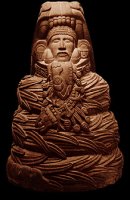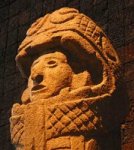

Kukulkán is
regarded as an
early Meso-American god that was known by the Mayans and Incas (and
possibly as early as the Olmecs), and was also known by the Aztecs and
Toltecs as as Quetzalcoatl (generally translated as: "plumed" or
"feathered serpent"), Viracocha from the Peruvian legends, and Gukumatz
by the K'iche' group of Maya.
In the historic-mythologic document: the "Popol Vuh", that is assumed
to have been written around 3100 BC by the Maya of Guatamala, Gukumatz
was described as: white skinned, caucasian-like, bearded, very tall,
having a long skull, and arrived in a "cosmic boat" (airship?),
accompanied by giant "African-like" warriors. During the time of the
Spanish conquest, the natives described him to the Spaniards as a man
with a white beard wearing a white robe.
To
the American native indians it was common practice to often name
people to certain animals, thus of course he was not a real
serpent. Maybe he was called the "feathered serpent" by the Aztecs
because of his supposedly white hair and beard, and his unusual head
gear. Facial hair was not known of by these natives and maybe they
never saw something like it, thus they might have associate his white
facial hair with feathers. It might be that his beard to
them looked like the tongue of a serpent, and maybe he also wore a
helmet which to them looked pretty much like the head of a
serpent. In ancient times the serpent was the symbol for wisdom
and Kukulkán/Quetzalcoatl was remembered by the ancients as a leader
and a bringer of civilization, knowledge and wisdom.
 According to
the book: "The Mayan Prophecies"
(1995), by Adrian Gilbert and Maurice Cotterell, Kukulkán was forced
to flee to the east because of a certain conflict where would have
left the Maya people with the promise that he would return some
day. Because it had long before been prophetized that Kukulkán would
return in the year with the name "1 reed", both the Maya
and their enemies: the Aztecs, who still had been sacrificing
ten-thousands of people every year, believed that it was the
righteous Kukulkán who had returned when the Spanish conquest
took place in the year 1519.
According to
the book: "The Mayan Prophecies"
(1995), by Adrian Gilbert and Maurice Cotterell, Kukulkán was forced
to flee to the east because of a certain conflict where would have
left the Maya people with the promise that he would return some
day. Because it had long before been prophetized that Kukulkán would
return in the year with the name "1 reed", both the Maya
and their enemies: the Aztecs, who still had been sacrificing
ten-thousands of people every year, believed that it was the
righteous Kukulkán who had returned when the Spanish conquest
took place in the year 1519.
This conquest was led by Hernán
Cortés, who believed that these people were some kind of devil
worshippers because of their bloody human sacrifices, who had to be
forcefully turned to the Catholic belief. As a result of this, most
of the books of the indigenous people were burned and most of the
ancient legends and knowledge eventually was lost.
The priest
Don Ramon de Ordoñez y Aguilar examined the site of Palenque in the
year 1773, and wrote about the earliest descriptions of the
ruins in his work: "A History of the Creation of Heaven and
Earth", which he referred to Palenque as the great city of
Nachan ("City of Snakes"). He argued that Palenque had
been build by people who arrived overseas by the Atlantic Ocean and
were lead by a man called Votan, who had a serpent as his symbol. The
story about Votan originally appeared in a book from the
early K'iche' group of Maya which had been partly copied by the
bishop Nuñes de la Vega before he burned the book in the year 1691.
According to the remaining copied text, Votan came into America with
his people who wore long garments. The indigenous people welcomed him
and subjected to his leadership and the strangers married with their
daughters.
Votan would travel four times back and forth over
the Atlantic Ocean to his old home, named "Valum Chivim",
which Ordoñez believed to be Phoenician Tripoli (in Lebanon)
and that Votan would be a Phoenician sea traveler. In chapter 4
of his book "Atlantis: The Antediluvian World" (1882),
Ignatius Donneley suggested that Votan built Palenque and that
"Valum-Votan" may have been a reference to Atlantis. He
also noted that the character of Votan is similar to the Germanic god
Wotan, and the Norse god Odin, thus possibly were one and the same
person. Lewis Spence also associated Votan with the Atlantis legend
in his book "Atlantis in America" (1925), where he
identified the name Votan as a local name for Quetzalcoatl.



